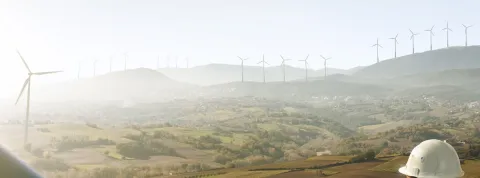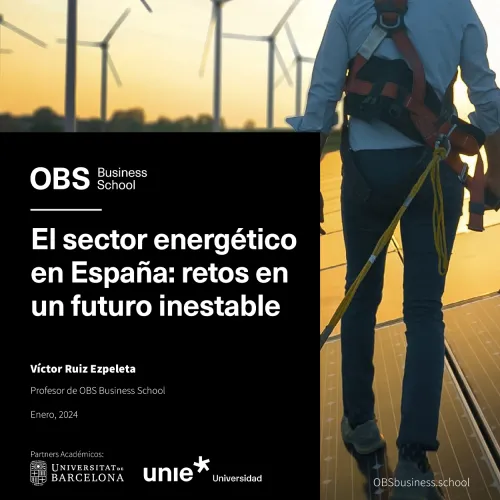
OBS Report: Spain's energy sector - challenges in an unstable future
50% of the energy consumed in Spain comes from renewable sources
- Spain is better than ever, but still far from the targets set; we are a global wind power in both equipment manufacturing and onshore power generation, however, our coastline presents problems for offshore wind farms.
- Castilla y León, Andalusia, Castilla-La Mancha, Aragon and Galicia are the Autonomous Regions that generate the most clean energy. Cantabria, Madrid and the Balearic Islands are at the bottom.
- The Balearic Islands, Catalonia, Valencia, Madrid, Navarre and the Canary Islands are the Autonomous Regions with the highest demand.
- Nuclear power continues to operate despite multiple oppositions and is, and will continue to be in the coming years, a reliable source of energy production.
January 2024. OBS Business School publishes the report Spain's energy sector - challenges in an unstable future, directed by the engineer and professor Víctor Ruiz Ezpeleta. The report consolidates the trend towards increasing energy production through renewable sources. During 2023, solar and wind energy continued to account for the majority of investments and projects, and this is expected to continue to be the case in the future. Green hydrogen is also expected to gain prominence, although its creation from renewables will need to be greater. "Renewable energy capacity will increase by a factor of three to four in the coming decades, and with the commitments made on fossil energy, its contribution will increase to more than 60%," says the report.
Renewable energy production
50% of the total electricity produced in Spain in 2023 came from renewable energies (14.3% more than in 2022) and continues to grow. A total of 116,844 GWh was generated thanks to benevolent weather conditions that benefited hydro, solar photovoltaic and wind power production, with significant increases over the previous year of 39.4%, 32% and 2% respectively. On November 3rd, the Spanish electricity system recorded its maximum share of renewables in the total electricity produced in a single day, with a share of 73.3%.
We are certainly better than ever, but still far from the targets set. "With the potential we have in terms of solar and wind energy, this percentage can and should be much higher in the coming years," says Professor Ruiz Ezpeleta. Our dependence on foreign energy was 69% in 2021. Therefore, not only must we reduce this figure, but we can also become exporters with the consequent economic and reputational benefits that this would entail. The generation of jobs and revenue from sales would make a vital contribution to the country's development and put it at the global forefront in terms of energy... but this requires further investment.
The European Union must continue to invest in research and energy technology to make up for the lack of materials to produce clean energy. Projects such as nuclear fusion, which is still a long way off but possible, could provide the definitive impetus for the abandonment of fossil fuels. In the meantime, more decisive steps towards renewable energy will have to be taken in the coming years in order to have 90% or even 100% of energy production from clean sources. The big challenge remains storage.
Energy production and demand by Autonomous Regions
There is a great imbalance between Spain's autonomous communities in terms of energy production and consumption. Those with the greatest weight in Spain's GDP are, however, in the minority in terms of energy production. The ranking is headed by far by Castilla y León, with 20,744 GWh generated, followed by Andalusia, Castilla-La Mancha, Aragón and Galicia with figures between 16,680 and 14,525 GWh. At the bottom are Cantabria, Madrid and the Balearic Islands, which do not even reach 500 GWh.
The report considers that some communities should become more involved and encourage the creation of energy generating parks in order to meet the EU targets for both 2030 and 2050. It also considers it necessary to speed up studies, projects, approvals and tenders in order to become less and less dependent on fossil fuels and energy from abroad. In terms of demand in our country, between January and September last year it was 183,762 GWh, 4.1% less than in the same period last year. The consumption of renewable energy reached 120,359 GWh in 2022, according to data from the nuclear forum, with a slight decrease caused by the decrease in hydroelectric power due to the shortage of water in the reservoirs.
The Autonomous Regions with the highest energy demand are the Balearic Islands, Catalonia, Valencia, Madrid, Navarre and the Canary Islands. Galicia and Cantabria are at the bottom of the list. It is clear, therefore, that those that consume the most are not those that produce the most. For this reason, the possibility of a regional electricity tariff to compensate those communities that produce much more than they consume has already been raised in some forums.
The price of energy
The price of gas, and consequently the price of electricity that reaches industries and homes, is being decisive for both large companies and small businesses. The cost of gas has had a major impact on glass, paper, food, ceramics, etc., which has led to a decrease in production and some have even considered closing down. The Spanish electricity market is liberalised and marginalist, which means that prices are not regulated by the government and everything is subject to auction. It is a market that the report considers unfair and does not respond to the laws of economics. In 2023, tariffs have been moderating and in recent months have fallen substantially, which has eased the economic burdens of many businesses. After the expiry of the so-called "Iberian exception" which, according to the Spanish government, has led to savings of more than 5,000 million euros, it remains to be seen how gas prices will react. 75% of the price will be set by the daily price and 25% by the futures price, a percentage that will vary over the years.
Wind energy
Offshore wind is a key technology in the EU, where it will grow from 12GW today to 60GW by 2030, according to the European Commission's "EU Strategy for Offshore Renewable Energy". It is one of the big bets of the renewable energy industry. However, although Spain is a global powerhouse in terms of both equipment manufacturing and energy generation, with 27.5 GW of installed power on land, making it the fifth largest country in the world behind China, the USA, Germany and India, our coastline presents problems when it comes to implementing offshore wind farms. We have a high depth and the technology of current projects allows foundations only up to 50 metres. However, the report indicates that a balance must be sought in order to take advantage of our more than 6,000 km of coastline.
Nuclear energy
Between 1996 and 2015, citizens paid the electricity companies a little over 5.7 billion euros (around 1.3 billion euros in interest alone) in surcharges on their electricity bills as compensation for the shutdown of the nuclear programme in Spain. The 1994 Law for the Organisation of the National Electricity System (Losen) established compensation for the companies affected by the investments already made. Thus, Iberdrola, Sevillana (later absorbed by Endesa), Unión Fenosa (now part of Naturgy) and Endesa received a total of almost 4.4 billion euros. However, this type of energy continues to operate despite multiple oppositions.
Currently, five nuclear power plants in Spain continue to produce electricity, with an installed capacity of 7,398 MW. In 2022, its seven active reactors generated almost 55,983.50 GWh. Right now, the contribution of nuclear energy in the Spanish energy mix is important, as one fifth of the energy consumed is produced by nuclear power plants. New technologies, such as fast reactors, could be a solution to extend this source. Fourth generation nuclear reactors, which offer significant advantages over existing designs in Spain and almost everywhere else in the world, could also be brought into operation in the next few years. These generators optimise the use of fuel, so that much less fuel would be needed and less radioactive waste would be produced. Furthermore, safety would be improved because, in the event of an accident, measures would only need to be taken in the area occupied by the plant.
Content by:
Carmen García-Trevijano
OBS Business School Press Office

